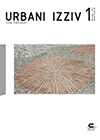Three elements in the construction of spatial identities in Mađir (Banjaluka, Bosnia and Herzegovina) and Ilsvika (Trondheim, Norway) neighbourhoods
Three elements in the construction of spatial identities in Mađir (Banjaluka, Bosnia and Herzegovina) and Ilsvika (Trondheim, Norway) neighbourhoods
Author(s): Kuvač Igor, Schwai MarkusSubject(s): Rural and urban sociology
Published by: Urbanistični inštitut Republike Slovenije
Keywords: elements of construction; spatial identities; new neighbourhoods; Mađir (Bosnia-Herzegovina); Ilsvika (Norway);
Summary/Abstract: The modern world is facing rapid urbanisation, increasing urban population, constant growth of cities and the construction of new neighbourhoods. Moreover, new neighbourhoods often lack the elements of identity in the context of the place and the people who live there. Therefore, it is necessary to construct these identities together with the physical and natural structure of place and the cultural identity of the people. The construction of spatial identities has been studied in two case studies of “new” neighbourhoods, Mađir (Banjaluka, Bosnia-Herzegovina) and Ilsvika (Trondheim, Norway), using a qualitative analysis method. The comparison makes use of a triangle model that includes three elements of identity construction as three points of analysis: a) spatial context, b) participation in processes of planning and construction and c) action in place. The two cultural contexts and two ways of constructing spatial identity in the new neighbourhoods studied show certain similarities and differences. The study points to the universal significance of this phenomenon and indicates that the process could be improved in each case by applying positive experiences from the other, with adaptation to the specific context. Considering the importance and interrelation of the three elements involved in construction of spatial identities, they should be harmonised in all stages of development.
Journal: Urbani izziv
- Issue Year: 28/2017
- Issue No: 1
- Page Range: 83-95
- Page Count: 13
- Language: English

